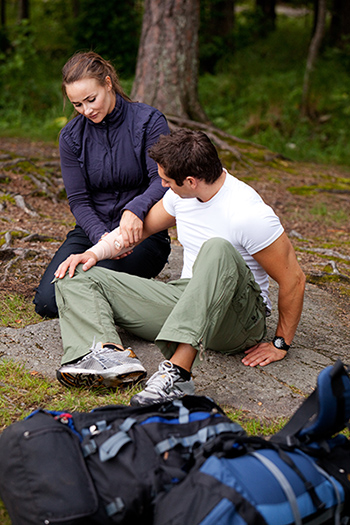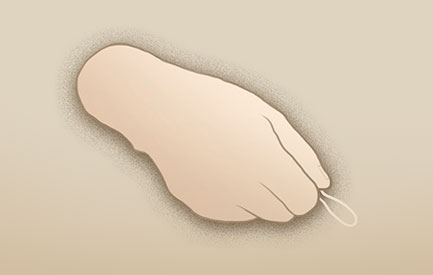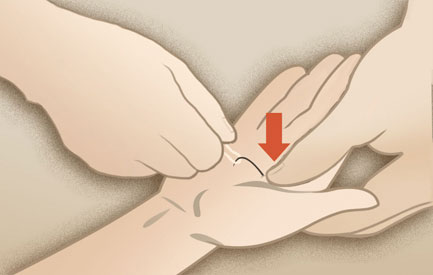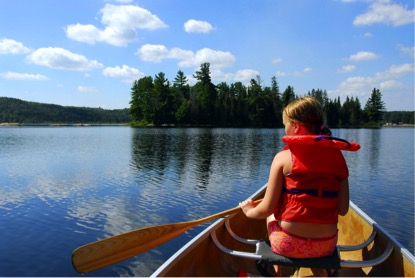Fishing Safety
Learn how to prepare yourself to be safe and comfortable on your next fishing trip. Consider these important fishing safety guidelines before embarking on your next adventure with your family and friends. Learn more about essential fishing safety gear, basic first aid, safety tips and more.
Fishing First Aid
When going out fishing always carry a fishing first aid kit with bandages, sterile pads, pain relievers, disinfecting liquids, antibiotic creams, forceps and wire cutters.

REMOVING A HOOK FROM YOUR SKIN: STEPS
STEP 1

Occasionally an angler will get a fishhook in the skin. Removing a fishhook is best left to a doctor or a hospital emergency room. Once a fishhook enters the skin beyond the barb, it is hard to remove.
STEP 2

There is a method that can be used to remove a hook if it is not in a vital area. First cut the hook away from the rest of the fishing lure. Then, put a loop of heavy twine or fishing line around the bend of the hook. Next, hold down the eye and shank of the hook, pressing it lightly to the skin. Grasp the loop in the line and, with a sharp jerk, pull the hook free.
STEP 3

Any hook wound should be followed by a tetanus shot if the victim has not had one in the past five years
CUTS AND BLEEDING
In all cases of serious bleeding where there is a large or deep cut, call a doctor, get the victim to a hospital, or call paramedics at once. Treat small cuts with adhesive bandages and antiseptic. For large or deep cuts, pressing directly on the wound with a clean gauze pad or handkerchief will reduce bleeding. Use the procedures taught at Red Cross training courses to ensure that proper amounts of pressure are applied.
HYPOTHERMIA
Hypothermia means your body is losing heat faster than it can produce it. Without treatment, your life is in danger. Exposure to the cold along with wind, wetness and exhaustion causes hypothermia. It doesn't have to be freezing cold for you to develop hypothermia. Many cases of hypothermia develop in air temperatures between 30 and 50 degrees Fahrenheit. Cold water takes away body heat 25 times faster than air of the same temperature. Any water colder than 70 degrees can cause hypothermia.
Protect yourself from hypothermia: Stay warm and dry. Remember that wind makes you colder. If you fall into cold water with a PFD on, it’s best to go to shore if possible. If not, don't thrash around. Excess movement speeds up heat loss. Instead, bring your knees up towards your chin and bend your legs as though you are sitting. This is called the Heat Escape Lessening Position or "H.E.L.P." This helps hold body heat and slows cooling.
How to detect hypothermia: Watch for these signs including uncontrollable shivering, fumbling hands, frequent stumbling, a lurching walk, vague slow speech, drowsiness or apparent exhaustion.
How to treat hypothermia:Get the victim out of the cold. Give warm drinks, remove all wet clothing and get the victim into dry clothes, and if possible, into a warm sleeping bag next to another person to provide body heat. Try to keep the person awake.
OTHER MEDICAL PROBLEMS
Other medical problems that may occur while you’re fishing are snakebites and broken bones. These are rare, but serious, emergencies. A person with a broken bone should not be moved until medical help arrives.
Snakes rarely bite if they are left alone. A person bitten by a poisonous snake should be kept calm and quiet and taken to a doctor or hospital at once. If possible, determine the type of snake that caused the bite.
Content courtesy of the Future Fisherman Foundation.
Prepare yourself to be safe and comfortable on your next fishing trip with these basic items.
Fishing Safety Tips
Follow these simple tips to enjoy a great fishing experience with your family and friends. Prepare yourself to be safe and comfortable on your next fishing trip.

FOLLOW THESE TIPS TO ENSURE A SAFE FISHING EXPERIENCE:
- If using a boat to fish, wear a life jacket and make sure each passenger wears one, too.
- Inspect waterfronts daily—the natural environment is subject to change without notice.
- Don't fish in areas where it is not permitted. These areas have been declared “off limits” to protect wildlife, vegetation, or for your safety.
- When choosing a site for fishing, always consider safety factors. Because fishing is practiced in a variety of environments, evaluate factors specific to safety in each environment.
- Bring along extra safety items such as water, flashlights, maps, and a cell phone or radio.
- Always wear foot gear appropriate to the conditions.
- Stay dry, warm and protected from the elements. Wear a waterproof sunscreen with an SPF (sun protection factor) of at least 15. Wear thin layers of clothing that progress outward to include water and wind protection as the final layer.
- Use appropriate insect protection measures, including proper clothing and repellents.
- Keep fishing knives sharp and cover the blade when not in use.
- Handle fish carefully.
- Use caution when baiting and removing hooks.
Fishing Safety Gear
Prepare yourself to be safe and comfortable on your next fishing trip with your family or friends. These are the basics items you will need in all weather.

SUNSCREEN
Too much sun can cause skin damage. A sunscreen lotion should be used to keep the sun's ultraviolet (UV) rays from reaching your skin. One with a Sun Protection Factor (SPF) of 15 provides good protection.
RAIN WEAR
All anglers must have rain wear. Several styles are available. A rain poncho is good, but many anglers prefer a two-piece rain suit with a jacket and pants.
Good rain wear is waterproof, not just water-repellent. It should have a full hood to protect your head, a storm flap over the jacket opening, a zipper, buttons or snaps, and elastic around the cuffs and ankle openings to keep water out.
SUNGLASSES
Sunglasses protect your eyes against the sun's glare. Many anglers like polarized sunglasses that reduce glare and let them see below the surface of the water to spot fish and other objects. Some sun glasses are treated to protect your eyes from the sun's harmful ultra violet light rays.
HIP BOOTS AND WADERS
Hip boots and waders are designed to keep you dry and protect you against the chill of cool water. For cold water wading, wear insulated boots. Hip boots only come up to your hips and are held in place with belt straps. Waders come up to the top part of your chest. They are held in place by suspenders and you should wear a belt on the outside. They will protect you while surf fishing, wading a stream or fishing in deeper water.
Under most circumstances, if you fall in the water with your hip boots on, do not try to remove them; first bend your knees. Air trapped in the boots will make them float at the toes. This can help keep you afloat as you paddle toward shore.
Content courtesy of the Future Fisherman Foundation.